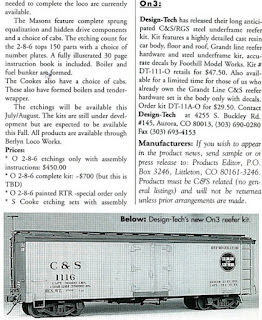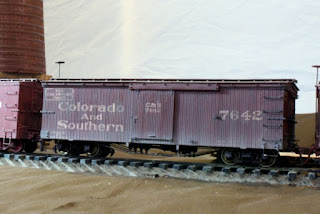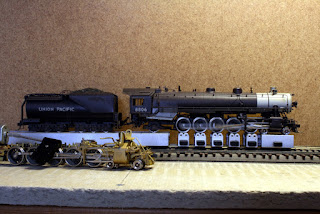In the Fall of 1995 Chris Lane and Paul Howald along with Doug
Heitkamp, Klaas Gunnick, and myself launched the Colorado & Southern
Narrow Gauge Historical Society. Paul was elected President, while
Chris took the ardent task of Editor of the Society magazine, The Bear Trap.
Doug, as well as Klass and myself were associate editors. Doug
published at least 2 technical drawings and regularly placed ads for Design Tech.
 |
| The title photo of the April 1994 article by Doug - Kits |
The purpose of The Bear Trap was to share accurate information about the Colorado & Southern narrow gauge and modeling subjects thereof. The first issue of The Bear Trap (Winter 1995) included a center piece drawing of the Forks Creek tank by Doug Heitkamp. He provided a short description of the tank and a photo by John Maxwell.
The same issue included an article that described the C&S ng cinder cars. That article included photos of Doug's 1/24th and my 1/48th scale models (04018 & 04082 respectively) The the C&S Connection had released a set of drawing of the cars (PK006) in 1988 and a description of the cinder car I built was published in Aug. 1991 Model Railroader.
 |
| Interior detail of 04018 - Kitts |
 |
| Underside detail of 04018 - Kitts |
 |
| Details, 1:24th scale Cinder Car 04018 featured in April 1995 Outdoor Railroader - Kitts |
 |
| The "B" end of the large scale 04018 - Kitts |
I believe he saw 04082 when he and his family visited us in Black
Forest CO in the spring of 1994. I probably supplied him with a copy of
PK006 but it would have been the MR article that
initially influenced Doug to build his model of 04018. A little discernment
suggests that he was probably already working on the model before he actually saw the 1/4"scale model.
Doug's model won the Freight Cars 1st Place Award at the 1995 Valley Forge National Narrow Gauge Convention. I saw his model several times over the years and it is an outstanding example of Doug's skills. It is an honor to have played a part in its success.
 |
| C&S 04018 in "the Colorado Road" scheme -Kitts |
In keeping with the mission of The Bear Trap, to promote prototypical information, I told nothing about how the models were built. Instead I focused on the history of the cars. We brought the models together as companions to the text and visual reference to what the real cars were like.
So far as we knew at the time, they were the only scale models of the cars in existence. Doug provided
a
photo of his model taken by Jerry Kitts and I added one for the O
scale model and a photo of 04082 for the cover of that issue.
In the same issue Design Tech placed an ad for their new O
scale C&S Refrigerator kit. The railroad built the composite or Steel Under Frame (SUF) reefers with hardware supplied by
Bettendorf Axle Co.; they were the first SUF cars built by the C&S in Dec. 1908. The DT kit built into a modern car but the modeler could backdated it to an original 500 series car. This
kit was an important addition to the products available to On3 modeling since at the time there had been no kit of the C&Sng reefers.
The kit was made up of cast resin parts - body and frame - but depended upon injected plastic part, such as the Grandt Line SUF kit and other commercial parts as well. For a short time DT offered the kit without the GL SUF at a reduced price. This was a consideration for those modeler who had already purchased the GL product.
 |
| DT Pilot model Reefer kit - Heitkamp |
In a later issue of The Bear Trap Chris Lane reviewed DT''s Refrigerator kit. The review included a photo of Doug's pilot model. As with all of Doug's models it demonstrated his intense attention to accuracy and craftsmanship.
 |
| Winter 1995 Bear Trap |
Michelle may still have this model but I have not seen it for a very long time.
 |
| Derrell's Conx 5 built 1987 - Poole |
Recently Darel Leedy and I were talking about models Doug built over the years and his On3 model of Conx 5 came up. The prototype belonged to the Conoco Oil Company; oil cars had been run on Colorado narrow gauge systems since about the turn of the century. This was the tank that, until 1935, was likely very similar to Conx 14. But a wreck on the South Park in 1935 obligated the C&S to repair the car. They mounted the tank onto a retired St. Charles coal car platform. This made the car unique among narrow gauge tanks and naturally, modelers gravitated toward it.
 |
| Conx 14 and rebuilt 5 at Leadville 1941 - Poole Coll. |
Darel knew more about Doug's model than I did. I don't believe I ever saw the model but Doug talked about it and may have shown me a photo. According to Darel, someone commissioned Doug to build the model. Darel remembered that the car won a First Place award at one of the narrow gauge meets. After winning the award Doug turned the model over to the owner who took it home and shortly thereafter sold it. None of us remember who bought it nor have any of us seen it since.
Darel also recalled that Doug told him there was something unique about the model that he had intentionally done. This was a marker so that if he ever ran across a Conx 5 he would know whether it was the model he built. Darel could not recall what it was that Doug did for this purpose.
While I may have seen a photo of Doug's Conx 5 no one seems to have any evidence of the car today. I built a Conx 5 for myself in 1987 and I have a photo of my car that I share in proxy. I think Doug would be okay with that since the models were on par with each other.
Doug's "signature" of his model was intentional but he knew it was already sold so it is understandably why he marked it. I wasn't planning to sell my Conx 5 when I built there was no marking intentional. Nevertheless, I know something about that car no one else would know and I probably could identify the model should I encounter it again. I would expect this to be a rather common practice among custom builders.
 |
| 1897 St.Charles box on Trout Creek Pass - Poole |
The last model shown here is an S (1:64) scale, 7616 series, C&S box car that came from the Denver Leadville & Gunnison in 1899. Well, except that the car smacks of a St. Charles type box car.
As the number on the model stands, that car would have been one of 120, 30' box cars built by the Peninsular Car Co. for the Denver South Park & Pacific in 1884. The specific car was previously 24500. It became 7642 on 22 Jan. 1900. But, comparing Doug's beautiful model to a prototype sister, 7646, it becomes clear that they were not the same build. The model represents a much later build than the Peninsular cars. The 7642 has St. Charles Car Co. hardware that included Rigid style trucks. Note that the trucks on 7646 were one of the Union Pacific swing beam types. There are other differences between the model and prototype as well.
The 24 cars of the original DL&G 6500 series (that were built in 1897 at the Union Pacific Denver & Gulf shops
in Trinidad CO) were among what we call the inherited cars because they had to be re-painted from a previous ownership trademarks. In Feb. 1899 the C&S began renumbering the inherited cars. The 6500 series cars became 7722 - 7746 and specifically 6520 became 7742 on 1-15-00. The "The Colorado Road" trademark on the cars was one of the most distinguishing differences between the Trinidad cars and the 40 box cars (8026 series) from St. Charles Car Co in the fall of 1898. This new set came already marked with a different C&S Ry trademark. Perhaps this is one of the reasons the 7722 series was among the most obscure group of cars on the C&Sng.
 |
| Ex DL&G Peninsular box at Kokomo, CO - Poole coll. |
Doug would have known all of this when he built 7642. So, notice that if the 6 on the model was replaced by a 7 the car would be
completely correct to the prototype - even with the The "Colorado Road Trademark". I never asked him about any of this but it may be that a modeler who already had a propensity to mark his craftsmanship might intentionally pervert the number to make the model uniquely his, no matter who eventually owned it. And, in those days, who would have known what number the car should have been? My personal belief is that Doug knew what he was doing for his own reasons.
 |
| Sn3 7642 on loan, TC Pass layout 2008 - Poole |
Doug's model is a superb example of his mastery of materials and technique. He described to me how he built it; all of the siding was taken from a commercial kit. However, he milled it on a Shirline machine to a thickness of about 1/3rd of the original material. There was no effort to match the sides to his model as intended in the kit. Instead pieces were cut and matched together as one might do with any sheet of scribed plastic. Doug gave me samples of this material and it is the typical light grey siding you would find in an Overland or P-B-L kit.
The purpose was to reduce a certain clunkiness of the commercial parts so
that scale lumber could be used for the frame. Very likely Doug used the C&S Connection drawings and other information that were by then in his possession. (See part 2 of this series.)
To be sure, I wanted the model. I tried more than once to talk him out of it. Instead he graciously loaned it to me for use on the Trout Creek Pass layout. It served there for a few years until we moved to Montana. I am told that Michelle keeps it in a display cabinet along with a few other special things. And rightly so; it is an heirloom to be cherished.
Like most of the models shared in this post, 7642 was a First Place "Freight Cars" award winner at one of the Sn3 Symposiums. It may have been in 2001 at the meet in Denver.
My thanks to Jerry Kitts for use of the photos and and Darel Leedy for his comments.










































